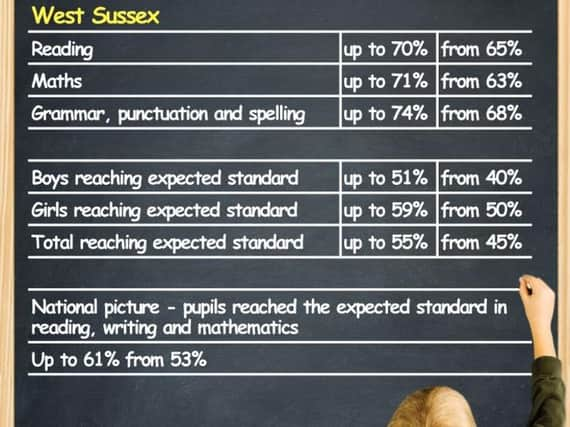SATs figures rise but still fall short of average


This was the second year of the tough new tests which saw the county’s 10 and 11-year-olds assessed on their reading and maths skills as well as spelling, punctuation and grammar.
The tests were taken in May and the provisional results for each local authority were published by the Department for Education last week. Complete information for each school is scheduled to be published in December.
Advertisement
Hide AdAdvertisement
Hide AdThis year, 55 per cent of West Sussex children reached the expected standard in all three areas, compared to just 45 per cent last year.
While that was an impressive improvement, it still failed to match the national average of 61 per cent, which itself rose from 53 per cent in 2016.
Regarding the improvement in the national figures, a Department for Education report stated: “This increase may be due to pupils and teachers further becoming more familiar with the increased levels of demand of the new assessments, aligned with the new, more challenging national curriculum, in their second year.”
The biggest improvement in West Sussex schools was made in maths, with 71 per cent of children reaching the expected standard, compared to 63 per cent last year.
Advertisement
Hide AdAdvertisement
Hide AdThe best results were recorded in grammar, punctuation and spelling, with 74 per cent of children reaching the expected standard, compared to 68 per cent in 2016.
Both results were a testament not only to the teachers and children but also the support programme put in place by West Sussex County Council over the past year.
When it came to reading, 70 per cent of children made the grade, compared to 65 per cent in 2016.
In line with the national picture, West Sussex girls still out-performed boys with 59 per cent meeting the expected standards compared to 51 per cent.
Advertisement
Hide AdAdvertisement
Hide AdBut, unlike the national picture, West Sussex boys closed the gap this year, improving by 11 per cent compared to 9 per cent for the girls.
Looking at the youngsters who performed at a higher level, data from the Department for Education showed boys led the way in maths while girls were top in reading and writing.
A council spokesman said: “West Sussex Key Stage 2 results improved in 2017 and are now closer to the national average.
“For pupils achieving the expected standard or better in all three subjects combined ie reading, writing and mathematics, West Sussex results improved by 10 per cent on those achieved in 2016. By comparison, national results improved by 7 per cent only.
Advertisement
Hide AdAdvertisement
Hide Ad“West Sussex’s programme of support for schools in 2016/17 concentrated particularly on writing and mathematics. In 2016 it was identified that across West Sussex a significant improvement needed to be made in writing at Key Stage 2.
“Our programme focussed on this and, as a result, Key Stage 2 writing has improved by 8 per cent for pupils reaching the expected standard or better, compared with 2 per cent nationally.
“Similarly, we have also focussed on supporting improvement in mathematics where Key Stage 2 results improved by 8 per cent against 5 per cent nationally.
“For 2017/18 West Sussex has in place a continuing comprehensive support programme for school improvement that focuses on English, mathematics and preparation for national assessment moderation.
Advertisement
Hide AdAdvertisement
Hide Ad“The School Improvement Strategy continues to provide a Link Adviser to support and challenge every school and academy and to provide additional support where there is the greatest need.”
The Department for Education has yet to publish complete local data comparing the performances of local authority schools with those of academies and free schools.
But the national figures showed schools maintained by local authorities performed better than sponsored academies and free schools.
Converter academies – already successful schools that chose to convert to academy status – performed the best, with 65 per cent reaching expected standards and 10 per cent reaching a higher standard.
Advertisement
Hide AdAdvertisement
Hide AdAfter analysing the results, school leaders’ union the NAHT called on the government to recognise that SATs were only part of the picture when it came to judging a school’s performance.
General secretary Paul Whiteman said: “This data is a useful indication of school performance but it is not the whole story.
“This should be a moment of reflection for schools but instead it is a moment of fear.
“In the past we have seen how data alone has led to schools being incorrectly and unhelpfully labelled as ‘failing’ or ‘coasting’.